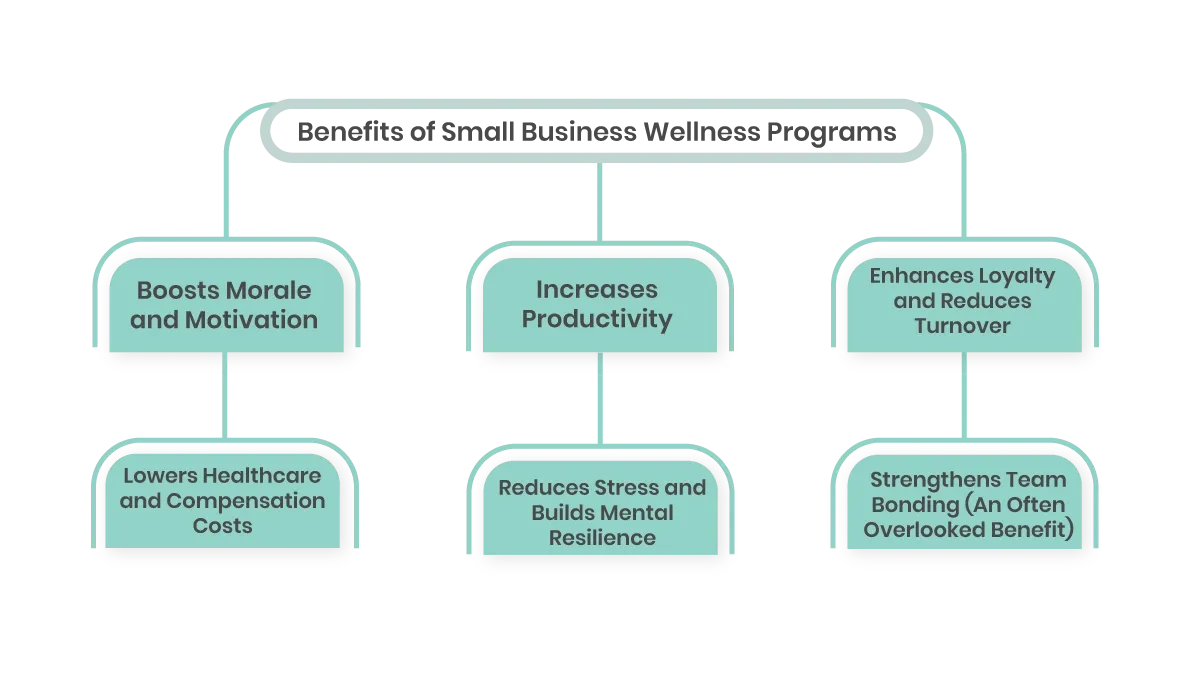The Ultimate Guide to Wellness Programs for Small Businesses
Running a small business isn't easy. On most days, it feels like ten things are tugging at the same sleeve. There's always something demanding attention, and health often gets forgotten in the hustle.
Most owners know their team's well-being matters, but between limited budgets and endless tasks, wellness programs can seem unrealistic or out of reach. It's easy to want more for the team, yet finding something simple, practical, and manageable adds one more thing to an already busy plate.
But wellness programs don't have to be complicated or expensive.
With smart, practical steps, small changes can boost everyone's energy, enhance employee well-being, and also reduce health costs.
This blog examines how small businesses can integrate wellness into their operations, benefiting both their employees and their bottom line. And how they can create a culture of health within their workplace.
What are Wellness Programs for Small Businesses?
Wellness programs for small businesses are a planned set of activities designed to help employees maintain their health. They are made for companies with fewer than 250 people.
These programs don't just focus on exercise or weight loss; they also address multiple dimensions of well-being, including physical, mental, financial, and social health. For example, nutrition workshops, mental health support, health screenings, fitness events, flexible work arrangements, and ways to balance work and life.
Some also include financial wellness education, telehealth access, mindfulness training, and preventive care. The goal is to help the person feel better overall, not just their physical body. This often leads to higher morale and job satisfaction.
Benefits of Small Business Wellness Programs

Well-run wellness programs bring real value to small businesses and their teams. Here are some key benefits worth knowing:
1. Boosts Morale and Motivation
When a small business invests in wellness, it's more than just a perk. Employees feel appreciated, which naturally boosts morale and fosters a more positive work environment. In fact, 77% of employees report that wellness programs have a positive impact on workplace culture.
In a small team, that energy is contagious. A single motivated employee can spark momentum across the entire group.
2. Increases Productivity
Healthy employees are sharper, more focused, and less likely to miss work due to illness. Wellness programs not only reduce absenteeism but also address a more subtle issue: presenteeism, which can actually increase productivity.
Companies with wellness programs see up to 21% higher productivity from engaged employees.
3. Enhances Loyalty and Reduces Turnover
In small businesses, losing even one employee can feel like a significant setback. That's why loyalty matters. Wellness programs help people feel supported and valued, making them more likely to stay engaged.
84% of employees with wellness programs report feeling adequately compensated compared to just 61% without programs. Think of it as building an invisible thread of trust. Employees know their well-being isn't just an afterthought, and in return, they're less tempted to jump ship when a recruiter calls.
4. Lowers Healthcare and Compensation Costs
Healthier employees mean fewer doctor visits, fewer chronic issues, and fewer workplace injuries. That translates into reduced healthcare costs and reduced workers' comp claims.
5. Reduces Stress and Builds Mental Resilience
Stress doesn't just live in people's heads. It creeps into deadlines, team dynamics, and even customer interactions. With 56% of employees experiencing burnout, wellness initiatives such as mindfulness workshops, walking meetings, or flexible schedules can help employees reset.
Over time, this builds resilience, which is invaluable in a small business where workloads can shift suddenly and everyone's juggling multiple hats.
6. Strengthens Team Bonding (An Often Overlooked Benefit)
One of the hidden superpowers of wellness programs is their ability to unite teams. A walking group, a group cooking class, or even a collective goal like "walk the distance from New York to LA" can turn coworkers into teammates.
We’ve made it simple to get started.
Download our easy-to-follow SOP template, which guides you through setting up, managing, and evaluating a wellness program tailored to your team's specific needs. No guesswork! Just practical steps to help you build a wellness program that fits your small business perfectly.
Real-World Success Story

Meet Landmark Group - a retail team that partnered with Vantage Fit to run a wellness program tailored to its employees, transforming a simple idea into daily momentum on the ground.
Within six months, average activity climbed by 34%, a tangible lift that employees could feel in their routines and leaders could see in the data.
Organizations often see absenteeism ease and engagement rise when a thoughtful wellness strategy takes root, reinforcing the positive buzz a story like this creates.
Cost of Implementing a Health and Wellness Program
To plan effectively, start by assessing the costs: both direct costs associated with programs and tools, as well as indirect costs related to the time and effort required to maintain smooth operations. That simple split helps right-size ambitions to budget, avoiding surprises while staying focused on outcomes that matter.
Small businesses can benefit from US tax incentives when implementing wellness programs. Companies with fewer than 25 employees may qualify for the Small Business Health Care Tax Credit, which is worth up to 50% of the health insurance premium costs when offering qualifying health plans.
Direct costs
Basic programs: Walking clubs, wellness challenges, or lunchtime yoga often come together with little more than coordination time, making them low- or no-cost entry points.
Incentives: Prizes like gift cards or fitness gear usually range from $10 to $100. You can also motivate your team without spending a dime by offering public recognition or extra work-from-home days.
Technology and apps: Wellness apps or wearable device subscriptions generally cost between $50 and $200 per employee per year.
Indirect costs
Administrative time: Someone has to plan, launch, and promote the program; spreading ownership across a small volunteer committee can reduce load and keep things moving.
Training and education: Budget for wellness champions and educational content, offsetting costs with webinars and community resources where possible.
Participation and engagement: Engagement lives and dies on rhythm. Internal communication, a simple calendar, and periodic challenges sustain interest and keep participation high.
For a detailed breakdown of corporate wellness program costs, check out our blog on Corporate Wellness Program Costs.
Thinking about cost-effectiveness? Vantage Fit offers flexible pricing to suit small business budgets while providing robust wellness solutions. Ready to make wellness work for your team without breaking the bank?
Explore Vantage Fit’s pricing plans today and see how easy it can be to get started.
Obstacles Small Businesses Face When Implementing Wellness Programs
Most small businesses in the United States and around the world strive to provide a caring environment for their employees. The tricky part isn't the intention, but rather the small hurdles that arise when trying to implement wellness programs in practice.
1. Limited Budget and Resources

If you’re running a small business, you already know how carefully every dollar has to stretch. There’s rarely a “wellness budget” sitting around waiting to be spent, and there usually isn’t an extra person on staff whose job is to organize programs.
That doesn't mean wellness has to be off the table; it just means owners often should think creatively. For example, instead of paying for fancy fitness perks, some businesses start with simple things like flexible breaks, group walks, or mental health check-ins.
2. Measuring Return on Investment (ROI)
Proving the program worked is another challenge. Healthier employees don't always translate to neat numbers on a balance sheet. Fewer sick days and better energy at work are wins, but they're hard to measure in dollars.
It's like trying to put a price tag on good workplace culture. You can feel the difference, but it's not easy to "calculate." Because of that, some business owners hesitate to invest, even if the long-term benefits could outweigh the initial cost.
3. The Health Insurance Puzzle

Many small businesses share health insurance costs with a group of other employers. Even if their employees become healthier and costs decrease, the savings are distributed across the entire group.
That means a small business might only see a modest 2-5% reduction in insurance premiums, even with an effective wellness program. Therefore, some wellness vendors may overpromise when they claim they can drastically reduce healthcare costs. The reality is more complex.
4. Administrative Burden
Managing a wellness program isn't just a side gig; it's a full-on commitment. 33% of organizations cite "difficulty for workers to find time to participate" as the top barrier in small businesses. Here, everyone's already multitasking, and adding event planning, staff updates, and progress checks can tip the scales into chaos.
But you can tap into "wellness champions" from your own crew. These enthusiastic volunteers can take the lead on activities, lightening the load and sparking real buy-in from the ground up. It's like turning a chore into a team adventure.
Tips for Starting a Wellness Program that Works for Small Businesses
With a handful of smart moves, you can roll out something that keeps everyone healthier (and happier) without draining your time or budget.
1. Secure Leadership Support

When the leadership team laces up for the lunchtime walk or attends the meditation session, people notice. Their visible support opens budgets, clears schedules, and sends the unspoken message: "We actually care." Without that stamp of approval, even the best‐designed program struggles to get traction.
2. Handling It In-House (But Carefully)
Keeping the program in‐house can save cash. But instead of dumping everything on HR (or, worse, yourself), recruit "wellness champions" - the upbeat coworker who runs 5Ks, the smoothie aficionado in accounting or the yoga‐loving sales rep.
Spread the work so no one is overly burdened.
3. Conduct a Needs Assessment
Skip the top‐down guessing game. A quick anonymous survey can tell you whether your crew is craving stress relief, nutrition tips, or a standing‐desk swap. When employees see their own suggestions appear in the program, they're far more likely to participate.
Sample Wellness Interest Survey Questions:
-
Which wellness activities interest you most? (nutrition education, mindfulness/stress management, fitness activities, financial wellness, flexible work options)
-
What health challenges do you face that impact your work performance?
-
Do you prefer digital wellness tools or in-person activities?
-
What time of day would you be most likely to participate in wellness activities?
-
What barriers prevent you from maintaining healthy habits at work?
-
How would you prefer to receive wellness information? (email, app notifications, team meetings, posters)
4. Define Clear Goals and Objectives
"Reduce absenteeism by 15% this year" sounds grand but vague. "Cut Monday sick calls in half by offering on‐site flu shots" is concrete. Select a couple of clear, measurable targets to begin with. You can always level up later.
5. Start small and build momentum
Think pilot, not rocket launch. Offer fruit in the break room instead of donuts. Host a ten‐minute stretch break before the afternoon slump hits. Little wins create buzz, and once people are hooked, rolling out bigger ideas (step challenges, mental health workshops) feels natural.
6. Offer Incentives
A $5 coffee card, an extra vacation day, and public shout‐outs are simple perks that can nudge fence‐sitters into action. The trick is to keep rewards both meaningful and sustainable.
7. Partner with a Broker or Wellness Vendor for Support

Specialty wellness vendors come armed with turnkey programs, tracking apps, and hard‐won lessons. Think of them like a GPS for your wellness journey, saving you from wrong turns and budget potholes while you focus on the rest of the business.
8. Make Wellness Part of the Company Culture
Hang progress charts where people pass by, like near the coffee machine or the corridor. Celebrate the team that has collectively reached 100 miles. Mention wellness wins in staff meetings. Over time, staying healthy becomes "just how we do things around here," not another line item on the to‐do list.
Start where you are, lean on your people, and keep it genuine.
Measuring Success
Measuring whether a wellness program "works" isn't just about dollars and cents. Focus on Value on Investment (VOI) alongside Return on Investment (ROI) to see the whole picture. Like how people feel, perform, and stay, alongside what the program saves costs.
ROI tells the straightforward financial story - did spending lead to savings, such as fewer claims or less absenteeism?
VOI widens the lens to include engagement, morale, retention, productivity, and even issues that are avoided and never make it to a spreadsheet. For example, stress that doesn't spiral out of control or a hospitalization that never occurs.
For small businesses, the broader VOI view often reveals the actual impact. For instance, how a program shapes culture and performance over the long run, not just next quarter's costs.
Final Thoughts
Rolling out a wellness program can feel like a leap, but it doesn’t have to be a giant one. Start with what’s doable. Be it, short challenges, mental health resources or a simple movement habit. And expand as participation grows and the wins become visible in day‑to‑day work and bottom‑line stability.
The sweet spot is a program that fits the team’s rhythms and budget, because consistency beats complexity every time in small business environments.
FAQs
1. What are some examples of cost-effective wellness program ideas for small businesses?
Cost-effective employee wellness program ideas include simple steps like encouraging walking meetings, offering healthy snacks, hosting stress-relief workshops, or providing access to free or low-cost wellness apps
2. What are some employee health benefit ideas for small businesses?
Employee health benefits can range from offering basic health screenings and flu shot clinics to mental health support programs and flexible work schedules that promote work-life balance.
3. How to start a wellness program at work?
Creating a corporate wellness program begins with understanding your team’s needs through surveys, setting clear goals, and starting small with manageable initiatives.
4. What are the best wellness program incentive ideas for small businesses?
Popular wellness incentives include recognition programs, flexible time off, gift cards, and wellness challenges with small prizes.
5. How to write a corporate wellness program proposal to secure leadership buy-in?
A strong wellness program proposal clearly presents the benefits, costs, and impact of the program. Use data to highlight potential ROI and VOI, align the program with company goals, and suggest a simple implementation plan to ease leadership concerns.
6. What are the best corporate wellness companies?
Top wellness companies offer customizable programs tailored to small businesses, including platforms such as Vantage Fit, WellSteps, and Wellable.
7. What are some creative office fitness challenge ideas for small businesses?
For an engaging office fitness challenge, consider ideas such as stair climbing competitions, step challenges, or team-based activity goals that encourage friendly competition and promote movement throughout the day.
8. Are there wellness program grants available for small businesses?
Yes, wellness program grants are available from government agencies, local health departments, and some private organizations. These grants help offset costs, making it more affordable to launch wellness programs.



